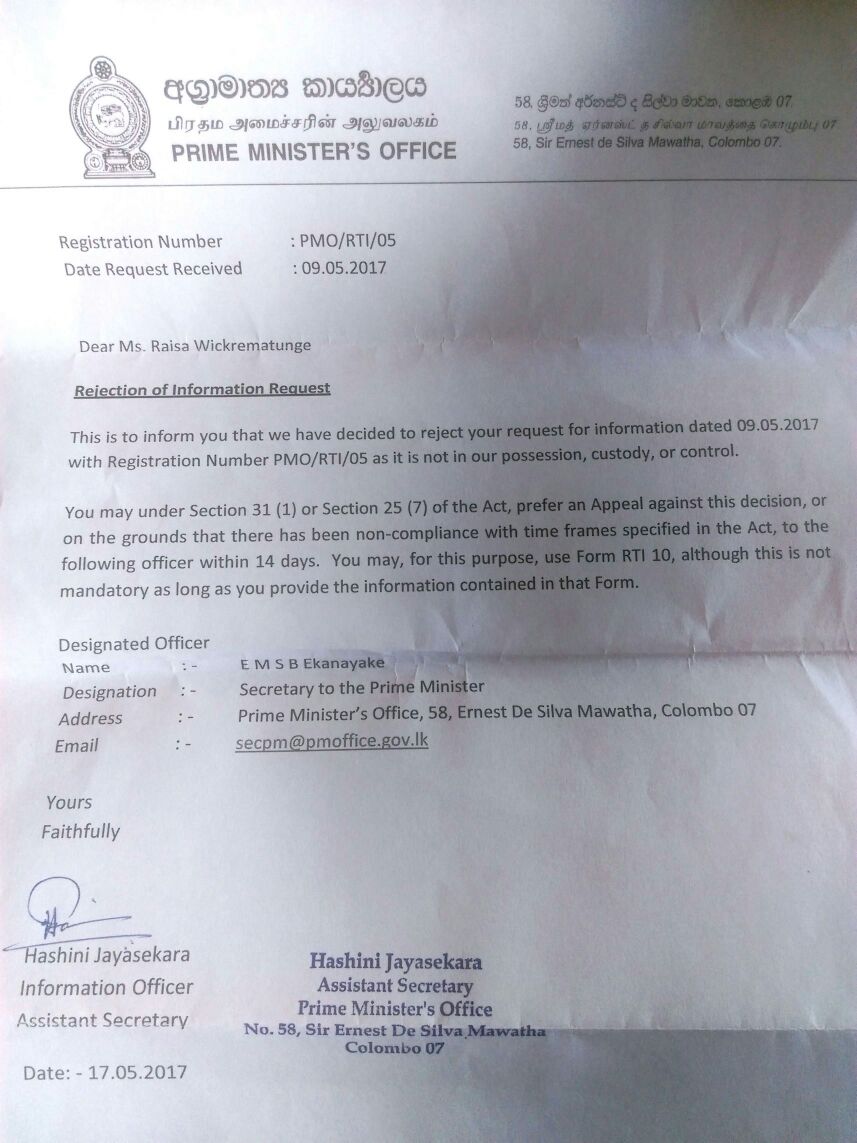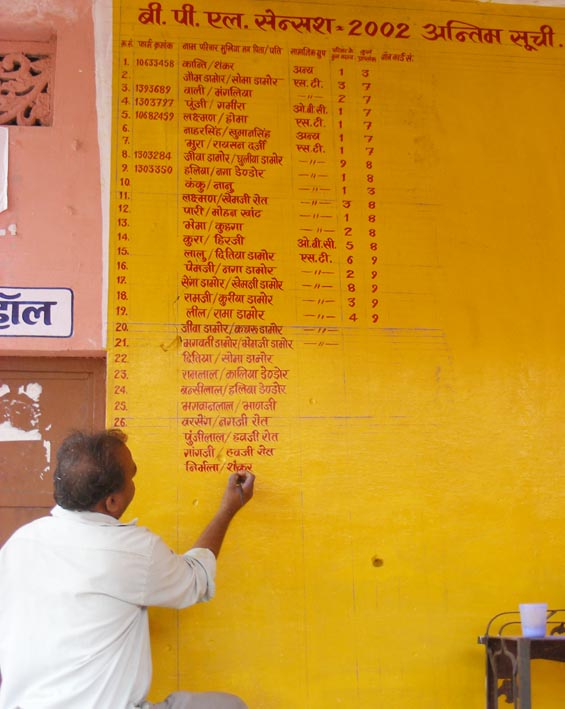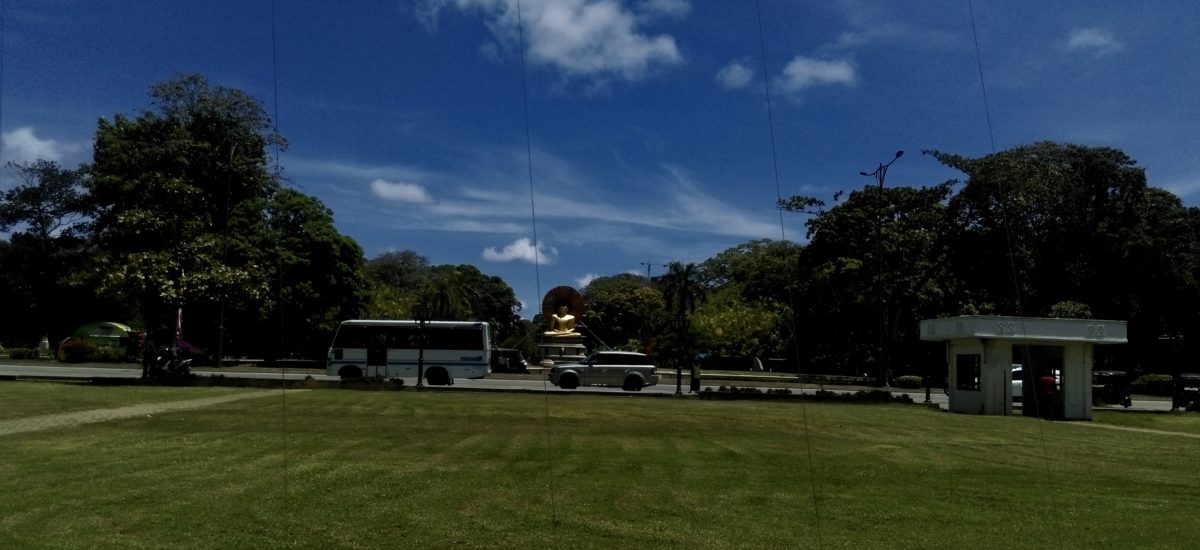On April 14, 2017 the garbage dump in Meethotamulla collapsed, killing 32 people. These deaths could have been avoided. That they could not, points to a systematic failure of the State to address various issues raised by the dumping of garbage close to human settlements. Residents from Meethotamulla went to the Supreme Court in 2014 seeking the relocation of the dump. Their calls went unheeded.
In the immediate aftermath, many State agencies were quick to absolve themselves of blame. When Groundviews contacted current Colombo Municipal Council Commissioner, V K Anura, he said that Meethotamulla had been used as a site from 2008. He also said that the CMC stopped disposing garbage in Meethotamulla in 2015, then recommenced it following a court order. Minister Champika Ranawaka meanwhile released documents saying that the Urban Development Authority had informed the CMC to stop dumping garbage in the area in September 2015.
The Commissioner flatly denied this.
In order to ascertain where the responsibility for Meethotamulla lay, Groundviews filed several RTI requests with a number of Government bodies; the Urban Development Authority (UDA), the CMC, the Central Environment Authority (CEA) the Disaster Management Centre, (DMC) the Ministry of Megapolis and Western Development, and the Prime Minister’s Office.
The responses (or lack thereof) revealed much not just about the operation of and coordination between state agencies, but also the implementation of Sri Lanka’s Right to Information Act.

Inside the CEA
The CEA was one of the first to respond to the request we filed (and incidentally, one of the best prepared to deal with RTI requests). In response to our query, they revealed that there had been no Environmental Impact Assessment (EIA) carried out before choosing Meethotamulla as a site for dumping garbage. The dumping commenced following a court order. Further, they said CMC had never made the request for an EIA to be carried out.
However it was the Urban Development Authority’s response that was most illuminating, pointing the finger of blame squarely at the CMC.
The first was a letter from the CMC, signed by then Commissioner Badrani Jayawardena to the Chairman of the UDA, identifying Meethotamulla as a site for dumping garbage, following a court order that was issued on April 28, 2009. The CMC Commissioner said that the area police and the Kolonnawa Pradeshiya Sabha were informed about the decision.
The second letter, dated September 6, 2016, was to the CMC. The letter, addressed to current CMC Commissioner V K Anura said that the UDA had only authorised 2 acres of land in Meethotamulla for the dumping of garbage. Instead, the letter said, the CMC had utilised all 21 acres of the land. The UDA further said that they required the land for ‘development purposes’ and asked that the CMC remove the solid waste at the site and hand over the land.
In addition, the UDA said that the CMC would have to pay a lease for the use of the land in Meethotamulla from 2009 until 2016, as well as bear the cost of ‘rehabilitating the land to its original position.’
The next letter, dated January 17, 2017, was to the Kolonnawa Development Council. The UDA Chairman noted that the CMC was continuing to dump garbage on UDA owned land, and threatened legal action if this practice continued.
The final letter, dated December 21, 2016, was to the Commissioner Anura once again. In it, the UDA noted that the CMC had not responded to the previous correspondence on Meethotamulla, or received any update on the situation there. As a result, the UDA ‘demanded immediate payment’ of the rental fees for the land, as well as the cost of restoring it to its original condition.
“If you fail to remit the said sum and/or hand over the vacant possession of the land on or before 10th January, 2017, UDA will institute legal proceedings,” the letter, signed by the Director General of the UDA, Engineer S S P Rathnayake.
As the letters reveal, just three months before the collapse of the garbage dump in Meethotamulla, the UDA had been requesting the CMC to take some kind of action – and received no response.
Groundviews also filed requests with the CMC asking for reports on action taken on the Meethotamulla dump prior to the landslide, as well as for any memos, written documents or records showing action taken following protests by Meethotamulla residents in 2016. After posting a formal acknowledgment of the request, the CMC’s Information Officer did not respond within the stipulated time frame of two weeks (which technically leaves him open to legal action under the Act). However, upon follow up, the Officer said the CMC was busy due to the flood situation, and would respond with the relevant information shortly. To date, there has been no further response from the CMC. (Edit: The CMC eventually responded to our RTI request – scroll to the bottom of this post for their response).
In some cases, the lack of response, or the refusal of information, was equally enlightening. Groundviews filed a request with the Office of the Prime Minister, asking specifically for any reports or documentation detailing action taken by Prime Minister Wickremesinghe after a meeting with residents in 2015, in which he had promised to solve the problem within 6 months. The Prime Minister’s Office rejected the request, saying the information we requested was ‘not in their possession, custody or control.’ The implication here is that there were no reports, memos, or documentation amounting to any concrete follow-up action taken by the Prime Minister, beyond making a verbal promise in 2015.

Letter from Prime Minister’s office, rejecting our RTI request
The Megapolis Ministry, after sending a formal acknowledgement letter on April 28th, did not respond within the two week stipulated time frame, while the DMC did not respond at all.
This in itself highlighted the differences in the way RTI has been implemented across state agencies.
RTI in Practice
Bodies like the CEA were extremely responsive and well-equipped to handle RTI requests. The receptionists manning the information desk were able to direct us to the designated Information Officer promptly and the Officer himself was clearly knowledgeable about the Act. The entire process of filing here was completed in just 20 minutes. An acknowledgment of the request was duly posted and the information received within two weeks. Despite rejecting our request, the Prime Minister’s Office was also fairly responsive, with the Designated Information Officer giving us an immediate acknowledgment of the request filed.
This is in stark contrast to the CMC, the DMC and the Megapolis Ministry. Not only did they not respond, but accessing the correct Information Officers was a time-consuming process.
The staff manning the reception desk in front at these bodies did not know the names of the designated Information Officer and also did not seem to have any knowledge about RTI in general. This is not the fault of the staff, but rather points to a lack of communication within these bodies. While the designated Officers, once located, were fairly well-informed about the Act, most of the staff did not know who these Officers were, and in which department. At the very least, it stands to reason that the staff manning the front desks should be equipped with the details of the Information Officers, and their locations in the building.
In India, government bodies often take the initiative to proactively disclose the contact details and names of designated Information Officers onto their official websites. In the Panchayats (the Indian equivalent of a Pradeshiya Sabha) details about the relevant officer was even painted on the walls, along with the relevant documents needed, to ensure that no one had to undergo undue difficulty when filing a request.

Photo of Panchayat wall painting courtesy P.C Kishan
There appears to be no such initiative here in Sri Lanka. In some cases, such as within the Urban Development Authority, confused staff would point us to the Director General, who would then point us to the Information Officer, often located in a completely different section. Compounding the issue is the fact that some bodies, the CMC for instance, have several Information Officers to process requests on different subject areas.
Some of the agencies (including the Prime Minister’s Office) also demanded to know additional details, such as place of work and the purpose of filing the request. However, the legislation itself ensures that every citizen has the right to file a request, and there is no need to provide a reason for doing so. The fact that the requests aroused suspicion and questions from some quarters highlights the fact that some government agencies are still clinging to procedures that veil their activities in secrecy.
And perhaps this is unsurprising, given what was revealed from the UDA – which points to the fact that the CMC willfully ignored repeated requests to remove the garbage from Meethotamulla, and restore the land to its original state, just four months prior to the collapse.
Groundviews will continue following up with the CMC, and will update this story with their response, if and when received.
In the public interest, here are the names of the Designated Information Officers for each of the bodies we approached for RTI requests:
P. S Somasekara,
Director (Geographical Information Systems)
Central Environment Authority:
M.S.A.E Thimalpola
Hashini Jayasekara
Assistant Secretary
J.M Aseem
Engineering Department
Ministry of Megapolis and Western Development:
A.W.M Sarathchandra
Pradeep Kodippili
UPDATE:
July 3, 2017: The Information Officer of the Ministry of Megapolis and Western Development, A W M Sarathchandra contacted Groundviews following the publication of this story. He promised to post a copy of a letter issued by the UDA asking the CMC to vacate the Meethotamulla site as partial fulfillment of our RTI request. However, he said he could not furnish details about alternative proposals for solid waste management, as the Ministry was currently looking at tender proposals on the same. Sarathchandra added that there was a proposal being considered to transfer the garbage to a site in Arawakkalu in Puttalam. Megapolis and Western Development Minister Champika Ranawaka recently announced that the Ministry would be using Korean technology in a recently signed US$.125 million (Rs.19 billion) project of which solid waste, treated and compressed into blocks at a plant in Kelaniya will be transported by train to Aruwakkalu in Puttalam to fill huge abandoned limestone pits, previously used by the Puttalam Cement Factory. It must be added that Sarathchandra responded well after the stipulated two week time limit for information officers to respond to an RTI request.
July 5, 2017: The Colombo Municipal Council responded to our RTI request, via their Information Officer J. M Aseem. In a typed letter, the CMC said they could find no documentary evidence for the Environmental Impact Assessment conducted on Meethotamulla. They also claimed that a meeting was held by the Colombo Municipal Commissioner at Town Hall following a 2016 protest by Meethotamulla residents. It was decided that they would receive Rs. 1.5 million in compensation for certain ‘identified residents’ to be relocated. The residents were asked to move from an identified area. They further said that one week before the landslide, a team comprising of officials from the Solid Waste Management Division of CMC, and the Public Assistance Department with the UDA inspected the dump site, identified the houses that needed to be evacuated with immediate effect and also did a detailed survey on the 101 watte, Dahampura and 23 watte areas. Despite saying this, the CMC said there was no evacuation notice issued two days before the landslide. The CMC also claimed that the UDA had never issued a notice asking the CMC to move out from Meethotamulla. They also said that all long term proposals on solid waste management were being scrutinised by the Ministry of Megapolis and Western Development. In response to a question on what mapping and assessments carried out before selecting Meethotamulla as a dump site, the CMC said that the land had been used as early as 1990, adding that the Kolonnawa Urban Council was already dumping garbage in Meethotamulla when the CMC was ordered to dump the garbage there as well.
It must be noted however that the CMC did not furnish any documentation to verify their claims, despite our RTI request specifically asking for documentation, notes, memos, and certified copies. What Groundviews received were typed responses from the Director Engineer of the Solid Waste Management Division – this too arrived well after the 4 week stipulated time frame for the provision of information (our request to the CMC was filed on May 9th). In addition, the CMC flatly denied that the UDA had issued any notice to them to evacuate, despite the UDA furnishing several letters which proved conclusively that such warnings were issued four months before the collapse of the site. This blatant lie puts the other responses into question, particularly given that there was no supporting documentation provided to back their claims.
Copies of the CMC’s response to our RTI request









